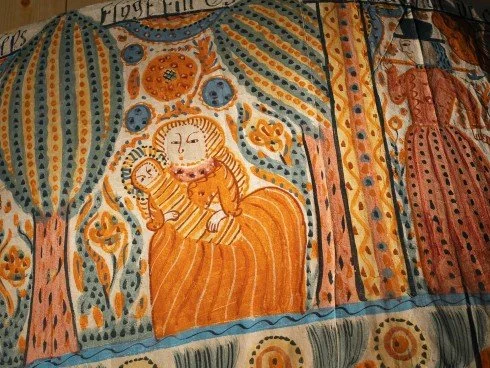Jonathan C. Lewis
Author and Artist
Time Travel
A fictional travelogue; four minutes to read.
At 10:06 am this morning I entered Stockholm’s Nordic Museum. It’s now 11:33 am.
Housed in a venerated brick building, the Nordic is a venerated museum venerating Swedish peasant life from the 16th century. How Swedes back then dressed, farmed, cooked, coped. How they played, prayed and reproduced.
The museum holds 1.5 million objects from vintage cooking utensils to heavily embroidered dresses, from wooden rocking chairs to religious artifacts, from candlesticks to horse-drawn carriages. There are five centuries of letters, diaries, memoirs, household accounts, folk stories, books and magazines.
The Nordic museum’s vaulted exhibition halls are like a mausoleum bursting with embalmed artifacts of the dead. Like the Swedish version of a pharaoh’s pyramid preserving for the afterlife painted toy horses, metal goblets and knitted mittens.
In the hushed murmurings of the museum, as I shuffle past the wood-carved spoons and rough-hewn furniture, I hear myself inhaling, exhaling, inhaling. My heartbeat slows. My thoughts roam free. I am freed of deadlines, duties, the details of life’s responsibilities.
A museum is time travel. A chance to visit cultures and customs entombed by eons of generational change. For $15.00, my admission ticket is a visa for crossing uncharted borders on maps without edges. Until closing time, I am living in two time zones—now and then.
Going back in time is looking at myself before I was born. I imagine my life without refrigeration or cell towers, without medicines or museums, with long workdays spent in the company of animals. My short lifespan plagued with incurable disease, withering malnutrition and pointless wars.
A history museum teaches life’s most personal and paradoxical lesson: time is endlessly finite. The desk clock in my hotel room, invisible in the dark and seldom noticed by day, ticks away the time whether I am awake or asleep, enjoying myself or not, happy or unhappy, using my minutes wisely or foolishly.
The best part of any history museum—blasphemy for a high school teacher to admit—is people-watching. Nothing is more romantic than an elderly couple holding hands in front of a display of wooden butter churns. Nothing is more intriguing than a solitary male with an expensive leather briefcase acting nonchalant in front of an old manuscript as he waits to rendezvous with an accomplice (or friend).
Two women dressed in greys and tans push strollers into my sightline. They whisper in Swedish, a language I don’t read, write or understand. I eavesdrop anyway. Maybe they are sisters sharing stories from their marriages or nannies working for families rich enough to afford them. Or kidnappers.
Everyone museum-meanders on their own timetable. Some visitors plow through the exhibits surveying the whole of the museum. Others cherish and linger in one room.
The Nordic doesn’t let me leave without taking seriously the entertainment value of time. Each curiosity here was once enjoyed by people who died. Did they idle away their time gazing at other people? Play checkers at the local pub? Do sports? Cook for pleasure? Travel?
Pausing at a glass case dedicated to daily apparel, I wonder if time-traveling tourists a hundred years in the future will be amused by an exhibition of my boxer shorts.




